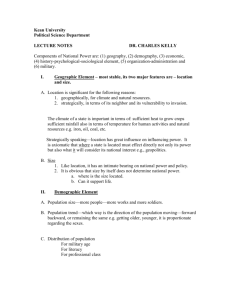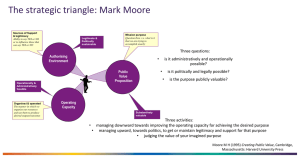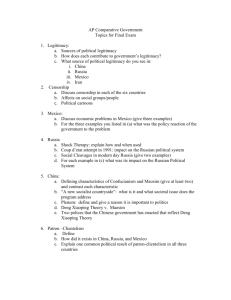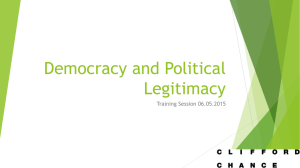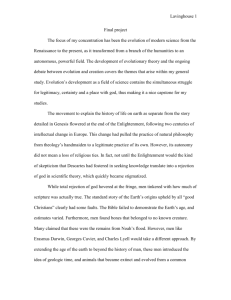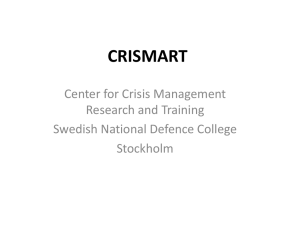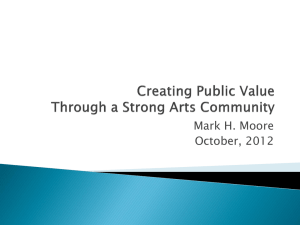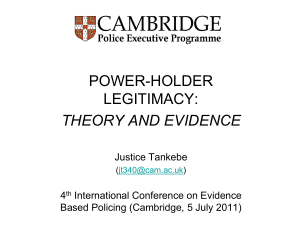Hitt/Black/Porter: Management 1st ed.
advertisement
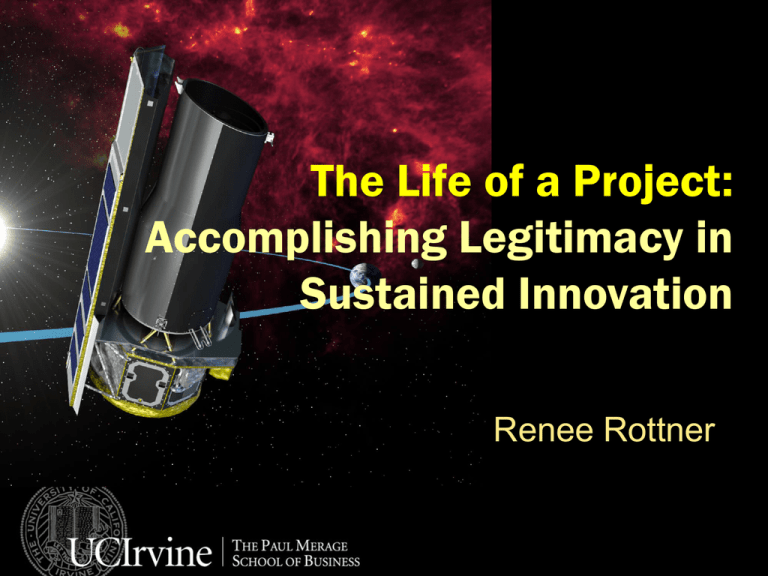
The Life of a Project: Accomplishing Legitimacy in Sustained Innovation Renee Rottner Why this study? • Sustained innovation is key to R&D projects of high scientific, economic, and political impact: – Pharmaceuticals, sustainable energy, aircraft design, military systems, basic research – Long development times, iterative innovation • Little is known about how innovation is sustained – It is fragile (Cheng & Van de Ven, 1996; Dougherty & Hardy, 1996 Jelinek & Schoonhoven, 1993) – Legitimacy is important (Arndt & Bigelow, 2000) Definitions Innovation: The creation and development of a new combination of materials or forces. (Schumpeter, 1934) Sustained innovation: management of multiple innovation efforts in coordination with past and future efforts (Bartel & Garud, 2009; Dougherty & Hardy, 1995) A longitudinal process involving… Legitimacy: perception that actions of an entity are appropriate or ‘right’ within some social system, assessed by stakeholders who have varying interests and criteria (Suchman, 1995; Reuf & Scott, 1998; Elsbach & Sutton, 1992; Zelditch, 2001) not a resource but a relation between power holders Research Question How is legitimacy accomplished in an innovation project over time? Context: An innovation project at NASA, 1972-2003 Method: Inductive, grounded theory building What do we know about legitimacy? Institutional Theory Interactionist Sociology Level of analysis Organizational fields Individuals Conception of legitimacy Characteristic of entity Relationship between entities Empirical focus Outcome Process Analytical focus Typologies (e.g., pragmatic, moral, cognitive legitimacy) Strategies Sources of legitimacy Components of institutions (cognitive, normative, regulative) “Gatekeepers of resources” * Deephouse, 1996; DiMaggio & Powell, 1993; Suchman, 1995; Ruef & Scott, 1998; Human & Provan, 2000 Fine, 1984; Strauss, 1978, 1982*, 1993 Blending the perspectives Inhabited Institutions • Actions are embedded in organizations (Barley, 2008; Bechky, 2009; Hallett, Schulman & Fine, 2009; Hallett & Ventresca, 2006) • Limited focus on legitimacy (Creed et al., 2002; Scully & Creed, 1997) • Limited empirical work (Binder, 2007; Hallett, 2010) • Not focused on innovation Need for building theory on legitimacy • Structuring of legitimacy (Barley, 2008) • Sequencing of legitimacy (Deephouse & Suchman, 2008 Suchman, 1995) • Creating and restoring legitimacy (Powell & Colyvas, 2008) • Across audiences (Suddaby, Hinnings & Greenwood, 2002) “Selling it”: Strategies for legitimacy Creating shared meaning & managing stakeholders • • • • • Storytelling (Lounsbury & Glynn, 2001) Issue selling (Dutton & Ashford, 1993; Dutton et al., 2001; Howard-Grenville, 2007) Discourse (Phillips, Lawrence & Hardy, 2004) Rhetoric (Creed, Scully & Austin, 2002; Suddaby & Greenwood, 2005) Impression management (Bansal & Clelland, 2004; Elsbach, 1994; Elsbach & Sutton, 1992) • Consensus of stakeholders (Neilson & Rao, 1987) • Framing (Rao, Morrill & Zald, 2000; Swaminathan and Wade, 2001; Dowell, Swaminathan & Wade, 2002; Fiss & Zajac, 2006; Kennedy & Fiss, 2009) Technology also carries meaning (Orlikowski & Scott, 2009; Carlile, 2002; Suchman, 2007) Research Design “Our biggest challenge was figuring out what to worry about and when to stop worrying about it.” —Deputy project scientist WHO IS DOING WHAT TO WHOM BY WHAT CRITERIA Actors Strategies Audience(s) Rules/norms • Project team • Power holders • Rhetorical • Material • Resource providers • Multi-level • Shifting • • • • Technical Scientific Political Economic Rhetorical vs. Material Rhetorical strategy: Material strategy: Persuasion through language Persuasion through structure or non-verbal actions (Orlikowski & Scott, 2009; Latour, 2005) Audience / Criteria Rhetorical Strategy Material Strategy NASA HQ Buildable? Write project proposals Run tests erawdraH emoS ,retaL Congress Affordable? Mention reuse of military tech Show prototypes 8991 ~ 92-83 Academics Usable? Publish articles on theory Build data centers ”1 Data: Longitudinal, multi-level, process Actors/Period ‘71-’83 ‘84-’89 ‘89-’96 ‘96-’03 Scientists 3 5 4 5 Engineers 2 3 2 6 1 1 2 Contractors Headquarters 2 3 3 2 Ext. Advisors 3 3 4 5 Feasibility Studies, Decadal Surveys, Budgets Meeting Minutes, Decadal Surveys, Budgets, Meeting Minutes, Decadal Surveys, Budgets, Diaries Meeting Minutes, Decadal Surveys, Budgets, Diaries #’s: people interviewed 850 pages of interview transcripts 20,000 pages of archival documents “Orphan moment” Bigger is not better 33 inches HQ: buildable? Congress: affordable? Academics: usable? Analysis steps 1. 2. 3. 4. 5. Longitudinal in-depth case history Identify critical events in timeline Examine actions before/after events Code the data for strategies Compare strategies of legitimacy over time Contributions to Theory • Legitimacy as: – a process (not an outcome) – at multiple levels – over time • Foundation for identifying and measuring legitimation strategies • Framework for sustaining innovation over time Questions Additional Slides • Temporal analyses of strategies • Legitimation Processes (Strauss, 1982) • Social movement theory Temporal analyses of strategies TIMELINES Political criteria Economic criteria Scientific criteria Technical criteria A. Event depth (major event or critical juncture in one period) B. Event breadth (one event that spans multiple criteria in one period) C. Frame depth (one event that spans multiple periods) D. Frame breadth (multiple events that span multiple criteria in one period) E. Diachronic (one criteria that spans multiple periods) Legitimation Processes (Strauss, 1982) • • • • • • Discovering and claiming worth Distancing Theorizing Standard setting, embodying, evaluating Boundary setting, boundary challenging Claiming, distancing, theorizing, standard and boundary setting Social movement theory Actions and resources are embedded in organizations and stakeholders Framing (Snow et al., 1986; Snow & Benford, 1988) – Diagnostic framing (what is the problem) – Prognostic framing (what is the solution) – Motivational framing (why should we do it) Resource mobilization theory – Resources matter, they are variable and come from a variety of sources (McCarthy & Zald, 1977, 2002) Making the invisible visible “Innovation was not simply suppressed it was unseen. It was ignored and invisible [by those] that could not understand its role.” —Dougherty & Hardy (1995:___) Bigger is better Making meaning material

